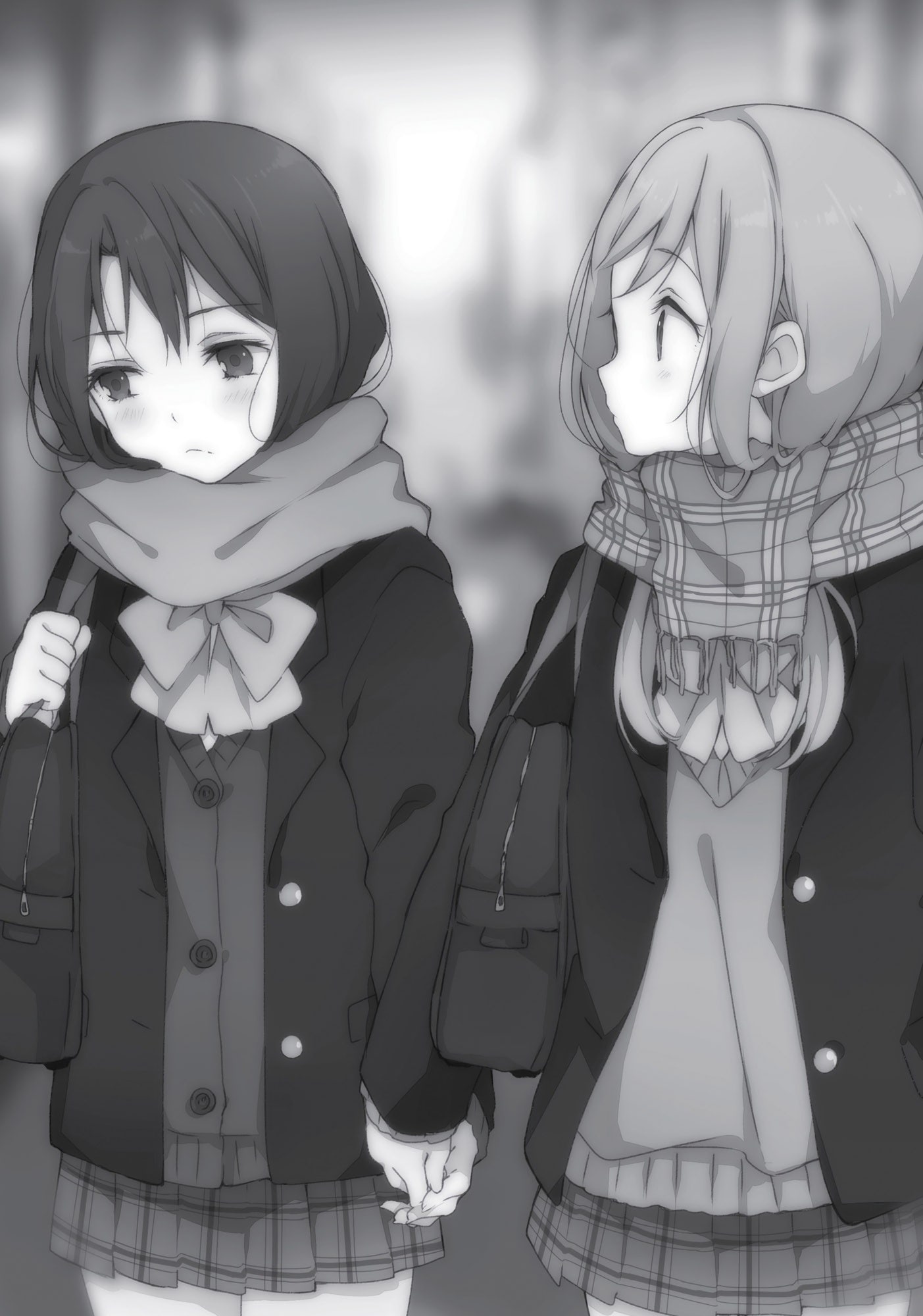Musing on Adachi and Shimamura

This post was originally hosted on Cohost. Since then, I’ve read through volume 11, plus 99.9. I’ve left the post as a whole unedited, however.
(I’m writing this in the middle of the second light novel, so I’m still in the dark of where this is all going. I’ve seen The Rant, though)
Bear with me.
While it wasn’t the first manga I ever read (I think that was either “The Hating Girl” or the Mega Man Zero adaptation), Toshihiko Kobayashi’s “Pastel” was the first one I really got into. I started reading it in 2007, when I was a high school senior.
Pastel centers on the relationship of the average Tadano Mugi (whose name can be read as ‘old wheat,’ which is lampshaded constantly) and the adorable Tsukisaki Yuu. It’s a dumb, ecchi shounen romance that went for, christ, 44 volumes from 2002 to 2017. I could explain more, but odds are you’re probably already familiar with the general setup and execution. It’s aged pretty poorly, and the English run never finished as far as I know.
I loved Pastel when I first read it. In Mugi, I saw myself: a slow-paced, unassuming guy who very clearly wanted to fall in love and spend my days peacefully with someone, but wasn’t able to actually seek it out. In my case, a good deal was anxiety, a good deal was undiagnosed autism. There was a barrier between me and actually romantically wooing someone, one I couldn’t put words to until a former therapist mentioned autism to me when I was 31.
I don’t know if Mugi is autistic, or if that was the intent. His inability to actually confess his feelings leads to a faintly sad yet nostalgic tone, a peaceful and laidback life with this girl. It elicits fleeting teenage summers, young love, and the inability to properly express yourself.
Mugi is frustrated at his love, wanting to be with Yuu but unwilling to danger their seemingly-fragile relationship, yet for many chapters is content simply to live with her, appreciating the shape of her in his life and what little initimacy he has. Unaware of what a real relationship would bring, for good or ill.
To spoil a manga two decades old, they do finally get together in volume 14. This is also where the English releases ended, as far as I could tell. If that’s true, then I appreciate Del Rey for sticking with it long enough for that payoff. I can’t imagine there were that many readers.
I dropped Pastel in the middle of volume 21, and even the fansubs only reach up to volume 34. A part of me wonders how it ends.
I’ve spent probably too much time musing about an entirely unrelated manga to what I’m actually talking about, but I feel a meandering, lazy review fits Adachi and Shimamura, as it does with Pastel. It’s just the vibe of these things.
Adachi and Shimamura centers on the relationship of, well, first-year high schoolers Adachi and Shimamura. Their given names don’t matter, and neither girl knows the other’s. I’m reading the original light novels, but there’s a manga and anime if that’s more your speed.
Both chronic underachievers, Adachi and Shimamura meet while independently deciding to skip class in their school’s gym, specifically the unused loft where the now-defunct Ping Pong Club used to practice. They strike up a cursory friendship, passing the time together in ping pong games, light conversation, or even mutual silence. Shimamura, our first POV character, dislikes the pressures of social interaction and expectation, preferring instead to space out and daydream:
In elementary school, my teachers always wrote “inattentive; lacks focus” on my report cards. To be honest, they weren’t wrong. My mind loved to wander; whenever there was a quiet period, I always ended up lost in thought. I lived for the moment when a daydream took root, whisking me away from the five senses chaining me to reality. In that regard, maybe I preferred being alone. After all, spacing out while in another person’s company was generally frowned upon.
Shimamura’s internality is an important part of her character. She has other friends but doesn’t think much of them. She’s annoyed by her parents and younger sister, as well as a strange, blue-haired, self-proclaimed alien (taking the form of a young girl about 8-10 years old). It’s weird. She drifts through life, uninterested but not overtly depressed, either. In introducing this story through her eyes, the author immediately sets the tone of the work: laid-back, almost dreamy, a hazy view of the margins of high school life in a quiet, boring suburb.
Then chapter three begins.
I had a dream that Shimamura and I kissed.
With the shift to Adachi’s POV, we’re given the main complication of the narrative. Adachi develops romantic feelings for Shimamura, while Shimamura continues to drift through life, taking things as they come. We also quickly learn that Adachi isn’t quite the same as Shimamura when it comes to social interaction:
My parents were convinced something was wrong with me. This was something I’d known for a while now. Personally, I would say I expressed my emotions a fair bit, but apparently they weren’t able to pick up on them for whatever reason. I wasn’t sure what exactly I was doing wrong—I was just imitating what everybody else did, or so I thought. Was it just a matter of interpersonal compatibility?
As an autistic person, I immediately honed in on this. Adachi mentions a strained relationship with her parents in other chapters, feeling like they merely share a house and nothing more. Shimamura actually meets her mother at a gym, who complains her daughter never communicates, gloomily keeping to herself.
When Shimamura’s friends crowd around her, Adachi clams up and stands to the side, waiting. She gives curt responses when spoken to.
Adachi constantly stares at Shimamura, whether during a karaoke outing or during class. Shimamura is somewhat off-put by this, though it piques her interest.
There’s more, but you get the idea. While the girls are similarly introverted on a surface level, their differences shine through in their POV chapters. As with Mugi (and Otherside Picnic’s Sorawo as another example), I don’t know if Adachi (or Shimamura, for that matter) was intended to be autistic, yet in reading her as such, I find the work becomes something a little more special to me.
The tension of Adachi’s attraction to Shimamura adds a delicate depth to an otherwise plain, slow narrative. Adachi and Shimamura isn’t unlike other high school slice-of-life romances, whether straight or queer. It fits a mold countless other stories before it have, Pastel first springing to mind for me. There isn’t much that sets it apart.
And yet I can’t find much fault with it. The novels are written well enough (though I feel the official translation is a bit heavy with its localization), and the plots are conventional but breezy. These characters struggle to communicate with each other, Adachi especially, and I find a strange sort of comfort in that. I’ve had very little romance in my life, habitually struggling to make my interests and affections known. I wondered why it was so easy for others, yet next-to-impossible for me.
In Adachi, as in Mugi, I see myself. Initially, Adachi struggles with these feelings and whether she’s lesbian or not, but it quickly turns into an inability to act on them. Her mind constantly focuses on Shimamura, yearning to bridge the connection, yet never knowing how to act. Never wanting to risk their fragile friendship breaking. Content (somewhat) with simply having Shimamura in her life. Adachi is much more focused and gloomy than Mugi ever was, yet still they suffer in silence.
This immediate connection with the character is innately compelling to me. I adore Adachi, and her attempts to connect with Shimamura remind me of my own. Many of us struggle with personal relationships and social interaction, and I find it comforting to see awkwardness portrayed honestly in media. While I’d certainly prefer to have the courage (Adachi’s term) to act confidently on my attractions, I find stories where characters do have it can throw me into a depression. If only it were that easy, right?
I can’t give a blanket recommendation for Adachi and Shimamura. To many people, it’s too much of a slow burn, too meandering, and there’s plenty of other, more tightly-wound yuri romances. The main leads (well, Adachi) are indecisive, prone to lazy daydreaming or agonized overthinking. It’s episodic and skips forward in its narrative, only keeping the thread of the two girls’ slowly growing relationship.
The first volume is four chapters long, while volume two has eight, with six short interludes. I prefer the latter case, it keeps each individual episode concise without sacrificing the slow, dreamy tone.
If, however, you’re like me and find this sort of thing strangely comforting (and have read this long), then you’d probably also like Adachi and Shimamura. I certainly do.
